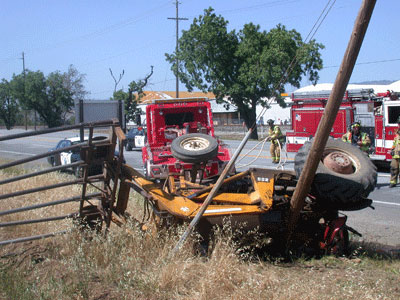
Tucker came from the San Martin shelter eight years ago. They called to let us know they had a beautiful yellow Labrador who needed to be adopted. We had just lost our three-legged dalmatian, Carly the tripod, and had room for one more. Tucker was a bit of a nervous, fearful dog in the beginning. However with lots of love and attention, he settled in and was very content with his new housemates … Archie, Maisy and our three cats.
Tucker had anxiety about new places and things. One day I was driving to do errands, and thought I’d let him come along for the exposure. I stopped by the veterinary hospital to check on some patients and left him in the car, knowing it would only be a few minutes and it was a cool day.
As I left the clinic and walked out to the car, I noticed the gardeners were blowing off the parking lot, finishing up their day. When I opened the car door, I saw foam in the backseat and thought,” Where did those pieces of foam come from?”
Turns out Tucker got so nervous hearing and seeing the gardener’s blowers he began chewing the seat and managed to chew up quite a bit of the back panel. I was reminded of the movie “Turner and Hooch,” but unlike Tom Hanks, I could barely mutter, “Tucker, don’t eat the car … not the car!”
Through the years, Tucker only had one more incident like that. We adopted a little poodle cross, who had to be taught not to chase our cats – especially Emma, the one who wouldn’t stand up for herself. The other two cats would just stare down or “pop” the new dog if he acted inappropriately. Emma always ran and started a short chase to her safe spot under the bed. “The pack” would follow and bark at her from the side of the bed. I suppose Tucker’s anxiety got the best of him during one of those episodes and he chewed the side panel off the mattress. That’s the way I found the bed. Covers all askew and most of the side panel missing. Brought back that movie again: “Tucker, don’t eat the bed … not the bed!”
The cat-chasing behavior had to end. The adopted poodle cross had to learn the cats were part of our family and our pack. I paid more attention to him and the cats and rewarded him when he was calm and quiet around them. However, after one more “chasing episode,” I decided to move on to a bit of negative reinforcement. I put a muzzle on the poodle and held him tight. Then I brought Emma over and just before she wrenched herself from my arms, she popped the poodle several times. This startled and scared him. He found out cats have a dark side!
Tucker’s anxiety vanished and he became the most loving dog we’ve ever had. He was always the first to greet us by jumping up to peer out of the window of the front door. This was also a great crime prevention tool! When I came home from a trip, he would jump up on me on the couch and actually wrap his arms around me. What a welcoming committee.
You could always tell if Tucker found a way into the trash or we had left something on the counters for him to eat or tear up. Tucker was a pro at “counter surfing” and could open every door and child gate, if they were not locked, bungeed or secured. Several loaves of bread, bags of chips and even a birthday cake were left unattended through the years to find their way into his stomach.
If Tucker did not greet us at the door, he was invariably cowering in the living room, with his ears all twisted and pulled back. I knew some food item or garbage had been discovered. I asked him, “Tucker, what did you do?” to cause more slinking, cowering and ear contortions. By the way, he only took a big bite out of the birthday cake, so we cut that portion out, and explained the missing piece away somehow.
I lost Tucker to cancer a few weeks ago. His unique personality and loving presence will always be missed. However, I know he had a chance to overcome his problems and live like a king for the eight years we had him. When pets no longer interact with the family or have some horrible or painful medical problem, a decision may have to be made to let them go. In those cases, it is a kind and loving decision for a painful, sick or senile pet who is just not happy. When I help clients through that process, it is important to consider the pet’s feelings and comfort. No one wants to let their pet go, but I couldn’t see that loving, beautiful Lab suffer. I loved him too much.
Greg Martinez, DVM, has worked at Gilroy Veterinary Hospital with Dennis Harrigan, DVM, for more than 30 years, and with Marc Van Every, DVM, for three years. Over the last 10 years, he has become very interested in the natural role of nutrition in treating chronic medical problems and to prevent future ones.








